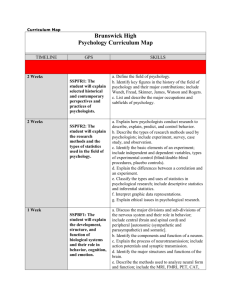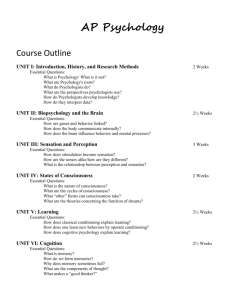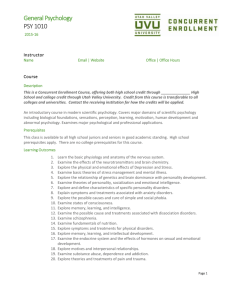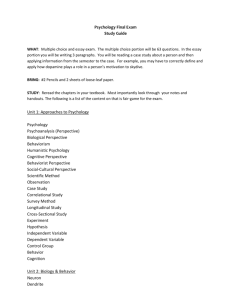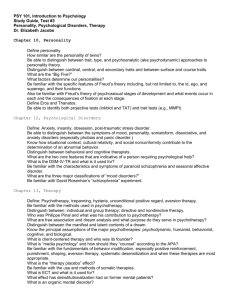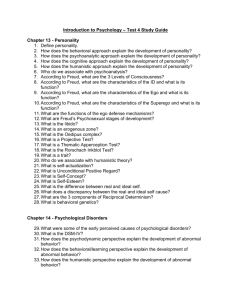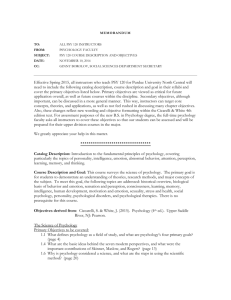Psychology II Course Description
advertisement
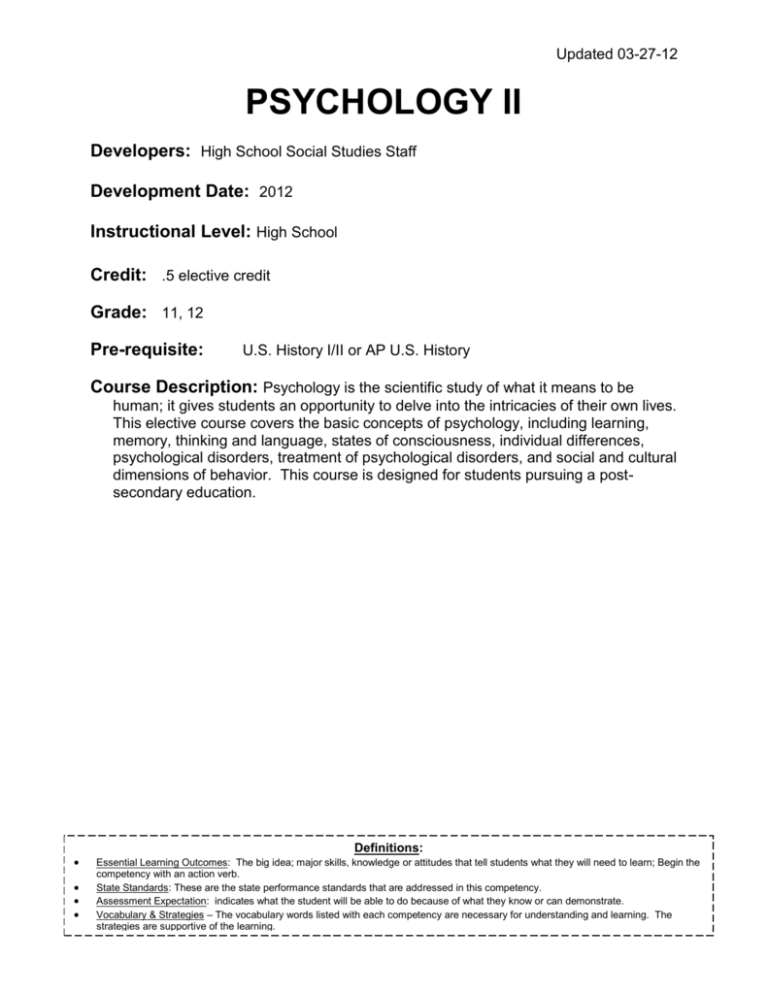
Updated 03-27-12 PSYCHOLOGY II Developers: High School Social Studies Staff Development Date: 2012 Instructional Level: High School Credit: .5 elective credit Grade: 11, 12 Pre-requisite: U.S. History I/II or AP U.S. History Course Description: Psychology is the scientific study of what it means to be human; it gives students an opportunity to delve into the intricacies of their own lives. This elective course covers the basic concepts of psychology, including learning, memory, thinking and language, states of consciousness, individual differences, psychological disorders, treatment of psychological disorders, and social and cultural dimensions of behavior. This course is designed for students pursuing a postsecondary education. Definitions: Essential Learning Outcomes: The big idea; major skills, knowledge or attitudes that tell students what they will need to learn; Begin the competency with an action verb. State Standards: These are the state performance standards that are addressed in this competency. Assessment Expectation: indicates what the student will be able to do because of what they know or can demonstrate. Vocabulary & Strategies – The vocabulary words listed with each competency are necessary for understanding and learning. The strategies are supportive of the learning. Updated 03-27-12 Linked State Performance Standards A. Geography: B. History: C. Political Science: D. Economics: E. Behavioral Science: 12.1; 12.2; 12.4; 12.5; 12.7; 12.14; 12.15; 12.16 Competency Topic #1: Individual Differences in Personality and Intelligence and Assessment Essential Questions/Enduring Understandings Are personalities constant over time or do they change with each new experience? How do psychologists define and study personality? What advantages and limitations exist for each theory’s description of personality? How do psychologists reliably measure personality and interpret personality’s role in behavior? Are intelligence tests culturally biased? What accounts for the group differences in intelligence scores? How do psychologists define and study intelligence? Student Assessment Expectations – Students meet Psychology II expectations when they: Describe Sigmund Freud’s psychodynamic perspective on personality. Explain how later psychodynamic theorists assessed personality and the new concepts added to psychodynamic theory by the neo-Freudians. Evaluate the validity of Freud’s theory using contemporary research findings. Describe the humanistic perspective on personality. Evaluate the validity of the humanistic perspective on personality using contemporary research findings. Describe the development of trait theories proposed by Gordon Allport, Raymond Cattell, and Hans Eysenck. Discuss the dimensions of the “Big Five” trait theory. Explain how traits theorists assess personality. Critique the strengths and weaknesses of the trait theory of personality. Discuss the social-cognitive theory of personality and how it explains the relationship among personality, the environment, and behavior. Critique the strengths and weaknesses of the social-cognitive theory of personality. Discuss the theory of the single intelligence versus the theory of multiple intelligences. Explain the historical development of intelligence tests. Contrast the different purposes of aptitude and achievement tests. Explain how tests are evaluated using the concepts of reliability and validity Discuss the causes of group differences in intelligence quotient scores. Vocabulary personality psychoanalysis psychodynamic perspective free association defense mechanisms psychosexual stages inferiority complex collective unconscious social-cognitive perspective personality inventories external locus of control Hans Eysenck intelligence emotional intelligence Howard Gardner David Wechsler preconscious unconscious id superego ego projective test Thematic Apperception Test (TAT) Rorschach inkblot test trait validity Gordon Allport Raymond Cattell reliability aptitude test Alfred Binet Lewis Terman humanistic psychology self-actualization unconditioned positive regard self-concept Sigmund Freud Alfred Adler Carl Jung Karen Horney Abraham Maslow Carl Rogers Minnesota Multiphasic Personality Inventory (MMPI) reciprocal determinism positive psychology Martin Seligman learned helplessness Albert Bandura internal locus of control general intelligence (g) mental age (MA) intelligence quotient (IQ) achievement tests Charles Spearmen Robert Sternberg Strategies reading guide discussion unit quiz unit exam Discovering Psychology Personality tests Who Am I? paper IQ test Updated 03-27-12 Linked State Performance Standards A. Geography: B. History: C. Political Science: D. Economics: E. Behavioral Science: 12.1; 12.7; 12.9; 12.14; Competency Topic #2: Learned and Unlearned Behavior and Memory Essential Questions/Enduring Understandings Is punishment effective in deterring unwanted behavior? Do rewards influence behavior? How do psychologists define learning? How do principles of classical conditioning work to create learning? How do principles of operant conditioning work to create learning? How do principles of observational learning work to create learning? Is memory accurate? Are repressed memories valid? How do humans encode, store, and retrieve information from memory? Student Assessment Expectations – Students meet Psychology II expectations when they: Use the classical conditioning model to explain an example of a classically conditioned response. Describe the sequence of the classical conditioning processes: acquisition, extinction, and spontaneous recovery. Describe how Ivan Pavlov discovered classical conditioning. Define the concepts of generalization and discrimination. Explain the behaviorist perspective, as described by John Watson. Discuss recent research findings indicating that cognition and biological predispositions are involved in some classically conditioned responses. Define operant conditioning. Define the law of effect, and explain the different kinds of reinforcement. Describe the effects of punishment and disadvantages of using punishment to control behavior. Explain how behaviors are influenced through shaping, discrimination, and extinction. Contrast the effects of different schedules of reinforcement. Discuss how cognition and biology influence the operant conditioning process. Define observational learning, and discuss the implications of Albert Bandura’s experiments. Discuss how observational learning can lead to prosocial and antisocial behaviors. Evaluate the effects of viewing violence in the media on aggressive behaviors and attitudes. Discuss the factors and techniques that influence whether information is encoded into memory Explain how memories pass through the sensory, short-term, and long-term memory stages. Identify and explain biological processes related to how memories are stored in the brain. Discuss the factors influencing how memories are retrieved. Explain how encoding failure leads to forgetting. Discuss the forgetting curve and how decay relates to forgetting. Describe how interference and motivated forgetting can cause forgetting though retrieval failure. Discuss how the misinformation effect can lead to false, constructed memories. Vocabulary learning classical conditioning unconditioned stimulus (UCS) unconditioned response (UCR) conditioned stimulus (CS) conditioned response (CR) partial reinforcement schedule fixed-interval schedule variable-interval schedule stimulus response acquisition extinction generalization discrimination behaviorism cognition reinforcement primary reinforcement punishment shaping latent learning cognitive map observational Strategies spontaneous recovery Ivan Pavlov John Watson Rosalie Rayner Robert Rescoria John Garcia operant conditioning positive reinforcement negative reinforcement secondary reinforcement continuous reinforcement overjustification effect Edward Throndike B.F. Skinner Albert Bandura antisocial behavior prosocial behavior reading guide discussion unit quiz unit exam Discovering Psychology Updated 03-27-12 fixed-ratio schedule semantic encoding implicit memory context effect state-dependent memory Hermann Ebbinghaus Elizabeth Loftus Sigmund Freud repression retroactive interference explicit memory learning model modeling vicarious learning encoding storage retrieval rehearsal overlearning chunking recall recognition permastore memory proactive interference variable-ratio schedule mirror neurons automatic processing effortful processing serial position effect self-reference effect mnemonic device method of loci peg-word system sensory memory short-term memory long-term memory flashbulb memory long-term potentiation misinformation effect Updated 03-27-12 Linked State Performance Standards A. Geography: B. History: C. Political Science: D. Economics: E. Behavioral Science: 12.1; 12.2; 12.4; 12.6; 12.7; 12.9; 12.12; 12.14; 12.15; 12.16 Competency Topic #3: Psychological Disorders and Treatments Essential Questions/Enduring Understandings How does society view the mentally ill? How do psychologists measure and define abnormal behavior? How are the various psychological disorders identified and studied? What impact do these psychological disorders have on individuals, families, communities, and society? Why do therapists use an eclectic approach when testing patients? How are the various psychological disorders treated? What impact do treatment options have on individuals, families, and society? What are legal, ethical, and professional issues in the treatment of psychological disorders? Student Assessment Expectations – Students meet Psychology II expectations when they: Define what a psychological disorder is and the criteria used to judge psychologically disordered behaviors. Explain the development and influence of the medical model of psychological disorders. Discuss the different components of the bio psychosocial approach to psychological disorders. Explain the purpose, uses, and criticisms of the DSM Manual. Discuss the benefits and potential dangers of diagnostic labels. Define anxiety and describe the different types of anxiety disorders. Discuss the biological factors and the learning factors that may contribute to anxiety disorders. Describe the different types of mood disorders. Discuss the biological factors and the social cognitive factors that may contribute to mood disorders. Describe the symptoms and causes of dissociative disorders. Describe the delusions, hallucinations, and inappropriate emotions or behaviors that are common to schizophrenic disorders. Discuss the biological factors and the psychological factors that interact to produce schizophrenia. Describe the different types of personality disorders. Define psychotherapy in general and Sigmund Freud’s psychoanalytic theory in particular. Discuss the assumptions of humanistic therapy. Explain how behavior therapy applies the principles of classical conditioning and operant conditioning. Discuss the basis of cognitive therapy and cognitive-behavior therapy. Explain the advantages of group therapy and when group therapy is most often used. Define the biomedical therapies, and describe their history. Explain how drug therapies are used to treat certain psychological disorders. Discuss the use and effectiveness of electroconvulsive therapy. Describe the history and effect of the use of lobotomies. Vocabulary psychological disorder bio-psycho-social model Diagnostic and Statisical Manual of Mental Disorders (DSM-IV-TR) dissociative identity disorder hallucinations psychotherapy eclectic approach psychoanalysis client-centered therapy systematic desensitization Philippe Pinel anxiety generalized anxiety disorder panic disorder phobia obsessivecompulsive disorder hypochondriasis schizophrenia delusions resistance interpretation transference token economy cognitive therapy Strategies posttraumatic stress disorder major depressive disorder bipolar disorder dissociative disorders dissociative amnesia dissociative fugue medical model personality disorders antisocial personality disorder somatoform disorders active listening behavior therapy cognitive-behavior therapy family therapy Sigmund Freud Carl Rogers reading guide discussion unit quiz unit exam Discovering Psychology Psychological Disorders Project Updated 03-27-12 aversive conditioning deinstitutionalization antipsychotic drugs antianxiety drugs biomedical therapy antidepressant drugs lobotomy electroconvulsive therapy (ECT) Updated 03-27-12 Linked State Performance Standards A. Geography: B. History: C. Political Science: D. Economics: E. Behavioral Science: 12.1; 12.2; 12.3; 12.5; 12.6; 12.9; 12.12; 12.15 Competency Topic #4: Social and Cultural Dimensions of Behavior Essential Questions/Enduring Understandings How do attitudes influence actions? Why is conformity valued so highly in society? Why are people attracted to each other? How are individuals affected by groups? How do attitudes and actions influence individual and group behavior? How do psychologists define culture? What influence does culture have on individuals and groups? Student Assessment Expectations – Students meet Psychology II expectations when they: Describe how attribution theory predicts the way we explain the behavior of others. Discuss how attitudes can affect actions and how actions can affect attitudes. Explain research findings related to conformity and obedience. Describe how being in the presence of others can affect performance, self-awareness, and self-restraint. Discuss how group membership affects thinking and decision-making. Explain the factors that influence attractiveness. Distinguish between passionate love and companionate love. Explain the factors that influence altruistic behavior. Discuss how stereotypes are formed and how they can lead to prejudice and discrimination. Discuss the biological and learning factors that cause aggressive behavior. Explain how shared goals can help resolve conflicts between groups. Define culture, and describe factors that influence how cultures develop. Discuss the effects of individualist cultures and collectivist cultures on sense of self, achievement motivation, and emotional perceptions. Describe the goals of cross-cultural research. Explain how culture influences the concepts of personality, development, and parent child attachment. Describe the effect of ethnocentrism. Vocabulary social psychology attribution theory fundamental attribution error foot-in-the-door phenomenon cognitive dissonance theory self-fulfilling prophecy just-world phenomenon cross-cultural research culture specific locus of control individualism ethnocentrism attitude conformity obedience deindividuation groupthink equity self-disclosure altruism prejudice stereotype discrimination ingroup outgroup ingroup bias aggression culture Strategies social facilitation social loafing group polarization Solomon Asch Stanley Milgram mere exposure effect passionate love compassionate love bystander effect scapegoat theory superordinate goals John Darley Bibb Latane Muzafer Sherif David Matsumoto collectivism reading guide discussion unit quiz unit exam Discovering Psychology


